8种基本时态的特殊用法
- 格式:doc
- 大小:767.50 KB
- 文档页数:5
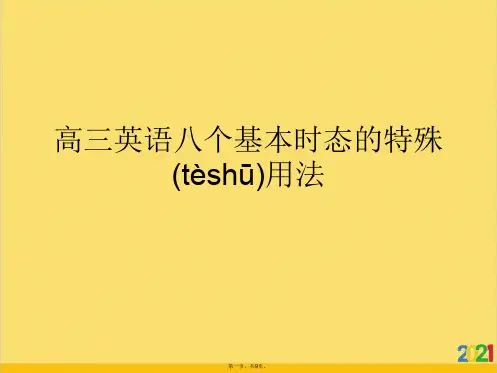
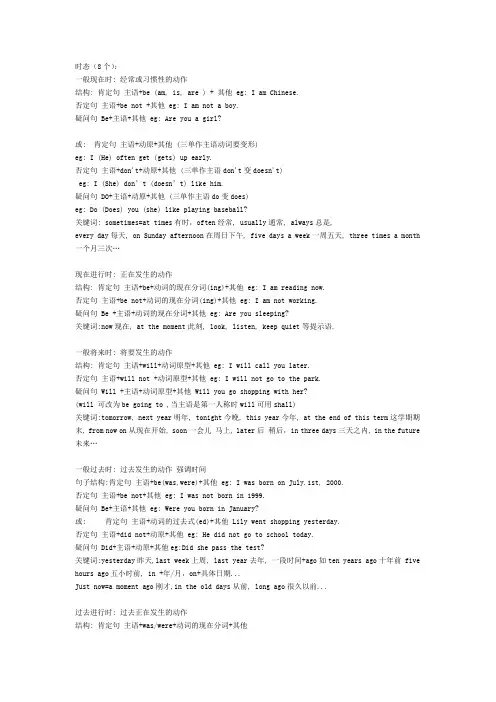
时态(8个):一般现在时: 经常或习惯性的动作结构: 肯定句主语+be (am, is, are ) + 其他 eg: I am Chinese.否定句主语+be not +其他 eg: I am not a boy.疑问句 Be+主语+其他 eg: Are you a girl?或: 肯定句主语+动原+其他 (三单作主语动词要变形)eg: I (He) often get (gets) up early.否定句主语+don't+动原+其他 (三单作主语don't变doesn't)eg: I (She) don’t (doesn’t) like him.疑问句 DO+主语+动原+其他 (三单作主语do变does)eg: Do (Does) you (she) like playing baseball?关键词: sometimes=at times有时,often经常, usually通常, always总是,every day每天, on Sunday afternoon在周日下午, five days a week一周五天, three times a month 一个月三次…现在进行时: 正在发生的动作结构: 肯定句主语+be+动词的现在分词(ing)+其他 eg: I am reading now.否定句主语+be not+动词的现在分词(ing)+其他 eg: I am not working.疑问句 Be +主语+动词的现在分词+其他 eg: Are you sleeping?关键词:now现在, at the moment此刻, look, listen, keep quiet等提示语.一般将来时: 将要发生的动作结构: 肯定句主语+will+动词原型+其他 eg: I will call you later.否定句主语+will not +动词原型+其他 eg: I will not go to the park.疑问句 Will +主语+动词原型+其他 Will you go shopping with her?(will 可改为be going to ,当主语是第一人称时will可用shall)关键词:tomorrow, next year明年, tonight今晚, this year今年, at the end of this term这学期期末, from now on从现在开始, soon一会儿马上, later后稍后,in three days三天之内, in the future 未来…一般过去时: 过去发生的动作强调时间句子结构:肯定句主语+be(was,were)+其他 eg: I was born on July.1st, 2000.否定句主语+be not+其他 eg: I was not born in 1999.疑问句 Be+主语+其他 eg: Were you born in January?或: 肯定句主语+动词的过去式(ed)+其他 Lily went shopping yesterday.否定句主语+did not+动原+其他 eg: He did not go to school today.疑问句 Did+主语+动原+其他eg:Did she pass the test?关键词:yesterday昨天,last week上周, last year去年, 一段时间+ago如ten years ago十年前 five hours ago五小时前, in +年/月,on+具体日期...Just now=a moment ago刚才,in the old days从前, long ago很久以前...过去进行时: 过去正在发生的动作结构: 肯定句主语+was/were+动词的现在分词+其他eg: I was doing my homework at 8 o’clock yesterday evening.否定句主语+was/were not +动词的现在分词+其他They were not staying at home at this moment last Sunday.疑问句 Was/Were + 主语+ 动词的现在分词+其他Were you sleeping when I called you last night?关键词:具体时间如:at ten o'clock yesterday morning, at this moment last Sunday上周日的这个时候...现在完成时: 过去发生的动作对现在造成的影响强调动作或其产生的结果结构:肯定句主语+have/has+动词的过去分词+其他(三单变成has)eg: This year alone, we've already planted ten thousand trees否定句主语+have/has not+动词的过去分词+其他eg: He has not arrived at home yet.疑问句 Have/Has +主语+动词的过去分词+其他eg: Have you been to China?关键词:already已经, yet还, just刚刚, ever曾经, never从不,so far目前, for +一段时间,since+过去的具体时间,this year alone今年以来,these five years alone这五年以来",in the last ten years 在过去的十年中…过去将来时:结构: 肯定句主语+ would+动原+其他 eg: I didn't know if he would come.否定句主语+ would not +动原+其他eg: They were not going to go hiking unless they finished their homework.疑问句 Would+主语+动词原型+其他 (would you like是词组一个固定搭配一般用表示礼貌的问)eg: Would you like to have a dinner with me?(would可改为was/were going to ,主语第一人称时would也可以用should)过去完成时:结构: 肯定句主语+had +动词的过去分词+其他eg: Mr. Smith died yesterday. He had been a good friend of mine.否定句主语+had not +动词的过去分词+其他eg: He said he has not been to America.疑问句 Had+主语+动词的过去分词+其他eg: Had he completed his homework by the time you got there.关键词: 句子中的两个动作都发生在过去一、一般现在时:概念:经常、反复发生的动作或行为及现在的某种状况。

英语动词时态总结一、一般现在时(Simple Present Tense)表示经常性动作、惯性动作、普遍真理等。
1. 动词原形:- I, you, we, they + 动词原形- He, she, it + 动词原形 + -s/-es2. 特殊用法:- 表示客观事实或普遍真理:The sun rises in the east.- 表示经常性或惯性动作:I often go for a run in the morning.二、一般过去时(Simple Past Tense)表示过去某个时间发生的动作或存在的状态。
1. 动词过去式:- 一般情况下,动词过去式在词尾加-ed。
- 不规则动词过去式需单独记忆。
2. 特殊用法:- 表示过去的经历或事件:We traveled to France last summer.三、一般将来时(Simple Future Tense)表示将来发生的动作或存在的状态。
1. will/shall + 动词原形:- I, you, he, she, it, we, they + will + 动词原形- I, we + shall + 动词原形2. 特殊用法:- 表示决定、承诺、意愿等:I will help you with your homework.四、现在进行时(Present Continuous Tense)表示现在正在进行的动作。
1. be(am/is/are) + 动词-ing:- I + am + 动词-ing- He, she, it + is + 动词-ing- You, we, they + are + 动词-ing2. 特殊用法:- 表示现在进行的动作:I am studying for the exam.五、过去进行时(Past Continuous Tense)表示过去某个时间正在进行的动作。
1. was/were + 动词-ing:- I, he, she, it + was + 动词-ing- You, we, they + were + 动词-ing2. 特殊用法:- 表示过去正在进行的动作:She was watching TV when I arrived.六、将来进行时(Future Continuous Tense)表示将来某个时间正在进行的动作。
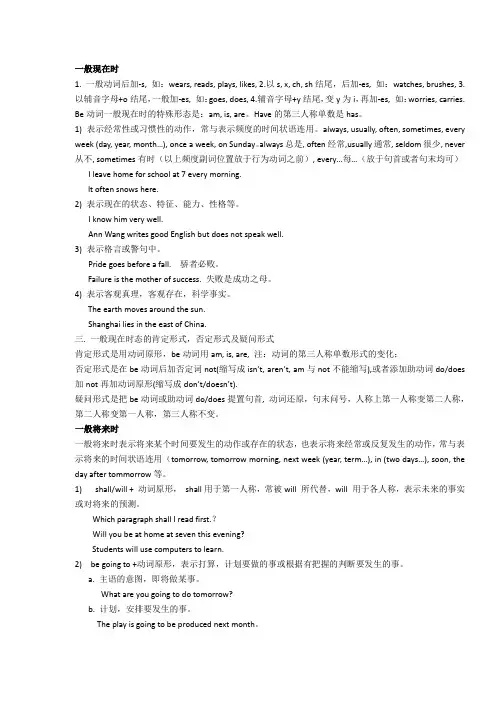
一般现在时1. 一般动词后加-s, 如:wears, reads, plays, likes,2.以s, x, ch, sh结尾,后加-es, 如:watches, brushes,3.以辅音字母+o结尾,一般加-es, 如:goes, does,4.辅音字母+y结尾,变y为i,再加-es, 如:worries, carries. Be动词一般现在时的特殊形态是:am, is, are。
Have的第三人称单数是has。
1) 表示经常性或习惯性的动作,常与表示频度的时间状语连用。
always, usually, often, sometimes, every week (day, year, month…), once a week, on Sunday。
always总是, often经常,usually通常, seldom很少, never 从不, sometimes有时(以上频度副词位置放于行为动词之前), every…每…(放于句首或者句末均可)I leave home for school at 7 every morning.It often snows here.2) 表示现在的状态、特征、能力、性格等。
I know him very well.Ann Wang writes good English but does not speak well.3) 表示格言或警句中。
Pride goes before a fall.骄者必败。
Failure is the mother of success. 失败是成功之母。
4) 表示客观真理,客观存在,科学事实。
The earth moves around the sun.Shanghai lies in the east of China.三. 一般现在时态的肯定形式,否定形式及疑问形式肯定形式是用动词原形,be动词用am, is, are, 注:动词的第三人称单数形式的变化;否定形式是在be动词后加否定词not(缩写成isn’t, aren’t, am与not不能缩写),或者添加助动词do/does 加not再加动词原形(缩写成don’t/doesn’t).疑问形式是把be动词或助动词do/does提置句首, 动词还原,句末问号,人称上第一人称变第二人称,第二人称变第一人称,第三人称不变。

英语八大时态结构及用法
英语的八大时态包括现在、过去、未来一般时,现在、过去、未来进行时和现在、过去、未来完成时。
以下是这些时态的详细信息:
1. 现在一般时:I eat an apple every day.(我每天吃一个苹果。
)
2. 过去一般时:She studied hard last term.(她上学期学习很努力。
)
3. 未来一般时:They will visit their grandparents next week.(他们下周将会拜访他们的祖父母。
)
4. 现在进行时:He is reading a book now.(他正在读一本书。
)
5. 过去进行时:They were having dinner when I called.(当我打电话的时候,他们正在吃饭。
)
6. 未来进行时:We will be eating pizza for dinner tonight.(今晚我们将会吃披萨作为晚餐。
)
7. 现在完成时:I have already finished my homework.(我已经完成了我的作业。
)
8. 过去完成时:She had written a letter before she went to bed.(在睡觉之前,她已经写了一封信。
)
9. 未来完成时:They will have finished their project by next week.(到下周为止,他们将会完成他们的项目。
)
以上是英语八大时态的结构及用法,希望对你有所帮助。
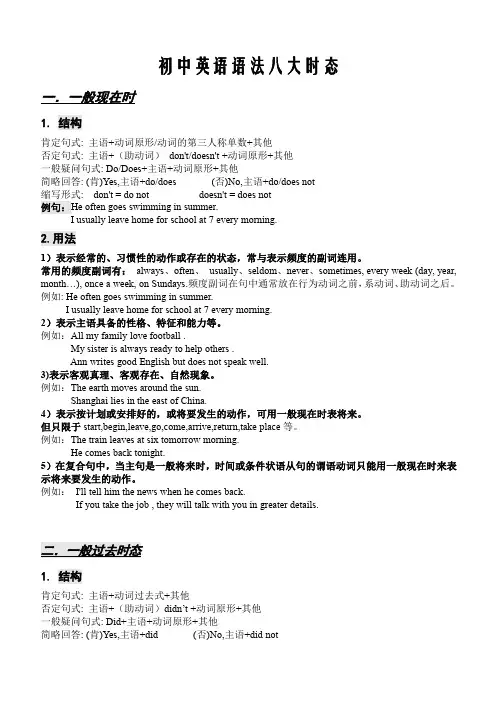
初中英语语法八大时态一.一般现在时1. 结构肯定句式: 主语+动词原形/动词的第三人称单数+其他 否定句式: 主语+(助动词) don't/doesn't +动词原形+其他 一般疑问句式: Do/Does+主语+动词原形+其他 简略回答: (肯)Yes,主语+do/does (否)No,主语+do/does not 缩写形式: don't = do not doesn't = does not 例句:He often goes swimming in summer. I usually leave home for school at 7 every morning.2.用法1)表示经常的、习惯性的动作或存在的状态,常与表示频度的副词连用。
常用的频度副词有: always、often、 usually、seldom、never、sometimes, every week (day, year, month…), once a week, on Sundays.频度副词在句中通常放在行为动词之前, 系动词、 助动词之后。
例如: He often goes swimming in summer. I usually leave home for school at 7 every morning. 2)表示主语具备的性格、特征和能力等。
例如:All my family love football . My sister is always ready to help others . Ann writes good English but does not speak well. 3)表示客观真理、客观存在、自然现象。
例如:The earth moves around the sun. Shanghai lies in the east of China. 4)表示按计划或安排好的,或将要发生的动作,可用一般现在时表将来。
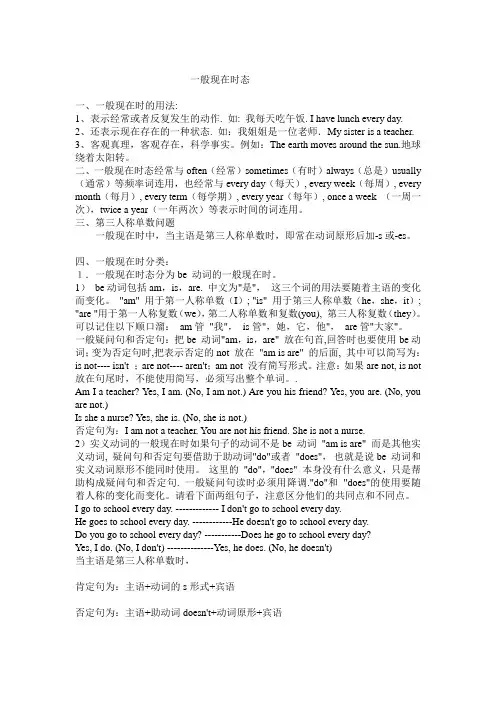
一般现在时态一、一般现在时的用法:1、表示经常或者反复发生的动作. 如: 我每天吃午饭. I have lunch every day.2、还表示现在存在的一种状态. 如:我姐姐是一位老师.My sister is a teacher.3、客观真理,客观存在,科学事实。
例如:The earth moves around the sun.地球绕着太阳转。
二、一般现在时态经常与often(经常)sometimes(有时)always(总是)usually (通常)等频率词连用,也经常与every day(每天), every week(每周), every month(每月), every term(每学期), every year(每年), once a week (一周一次),twice a year(一年两次)等表示时间的词连用。
三、第三人称单数问题一般现在时中,当主语是第三人称单数时,即常在动词原形后加-s或-es。
四、一般现在时分类:1.一般现在时态分为be 动词的一般现在时。
1)be动词包括am,is,are. 中文为"是",这三个词的用法要随着主语的变化而变化。
"am" 用于第一人称单数(I); "is" 用于第三人称单数(he,she,it); "are "用于第一人称复数(we),第二人称单数和复数(you), 第三人称复数(they)。
可以记住以下顺口溜:am管"我",is管",她,它,他",are管"大家"。
一般疑问句和否定句:把be 动词"am,is,are" 放在句首,回答时也要使用be动词;变为否定句时,把表示否定的not 放在"am is are" 的后面, 其中可以简写为:is not---- isn't ;are not---- aren't;am not 没有简写形式。
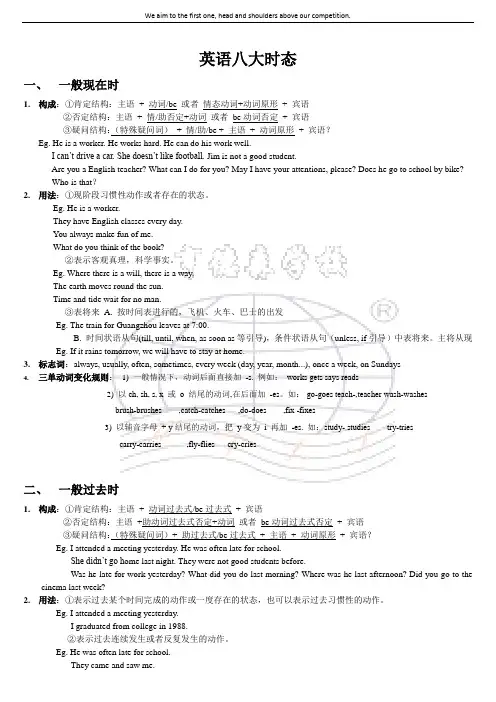
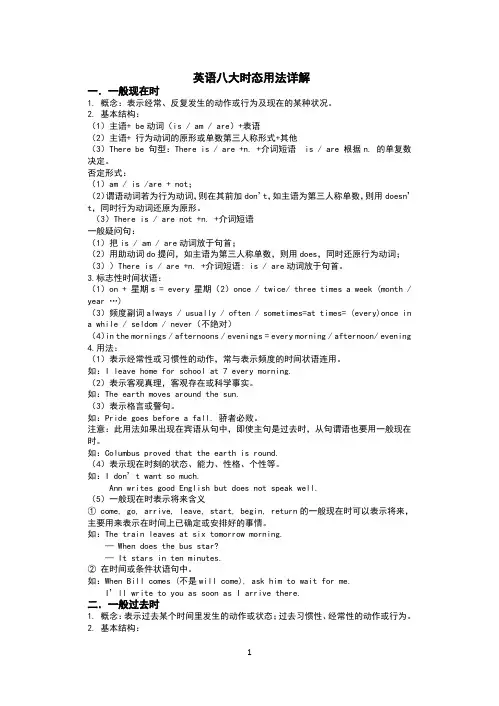
英语八大时态用法详解一.一般现在时1. 概念:表示经常、反复发生的动作或行为及现在的某种状况。
2. 基本结构:(1)主语+ be动词(is / am / are)+表语(2)主语+ 行为动词的原形或单数第三人称形式+其他(3)There be 句型:There is / are +n. +介词短语 is / are 根据n. 的单复数决定。
否定形式:(1)am / is /are + not;(2)谓语动词若为行为动词,则在其前加don’t,如主语为第三人称单数,则用doesn’t,同时行为动词还原为原形。
(3)There is / are not +n. +介词短语一般疑问句:(1)把is / am / are动词放于句首;(2)用助动词do提问,如主语为第三人称单数,则用does,同时还原行为动词;(3))There is / are +n. +介词短语: is / are动词放于句首。
3.标志性时间状语:(1)on + 星期s = every 星期(2)once / twice/ three times a week (month / year …)(3)频度副词always / usually / often / sometimes=at times= (every)once in a while / seldom / never(不绝对)(4)in the mornings / afternoons / evenings = every morning / afternoon/ evening 4.用法:(1)表示经常性或习惯性的动作,常与表示频度的时间状语连用。
如:I leave home for school at 7 every morning.(2)表示客观真理,客观存在或科学事实。
如:The earth moves around the sun.(3)表示格言或警句。
如:Pride goes before a fall. 骄者必败。
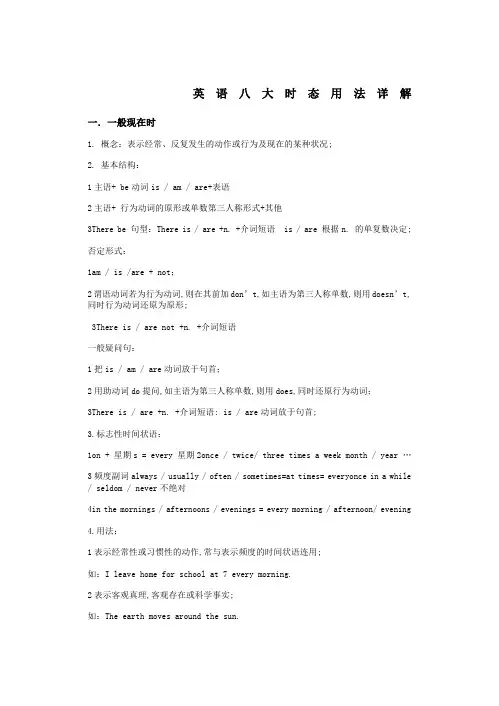
英语八大时态用法详解一.一般现在时1. 概念:表示经常、反复发生的动作或行为及现在的某种状况;2. 基本结构:1主语+ be动词is / am / are+表语2主语+ 行为动词的原形或单数第三人称形式+其他3There be 句型:There is / are +n. +介词短语 is / are 根据n. 的单复数决定;否定形式:1am / is /are + not;2谓语动词若为行为动词,则在其前加don’t,如主语为第三人称单数,则用doesn’t,同时行为动词还原为原形;3There is / are not +n. +介词短语一般疑问句:1把is / am / are动词放于句首;2用助动词do提问,如主语为第三人称单数,则用does,同时还原行为动词;3There is / are +n. +介词短语: is / are动词放于句首;3.标志性时间状语:1on + 星期s = every 星期2once / twice/ three times a week month / year …3频度副词always / usually / often / sometimes=at times= everyonce in a while / seldom / never不绝对4in the mornings / afternoons / evenings = every morning / afternoon/ evening4.用法:1表示经常性或习惯性的动作,常与表示频度的时间状语连用;如:I leave home for school at 7 every morning.2表示客观真理,客观存在或科学事实;如:The earth moves around the sun.3表示格言或警句;如:Pride goes before a fall. 骄者必败;注意:此用法如果出现在宾语从句中,即使主句是过去时,从句谓语也要用一般现在时;如:Columbus proved that the earth is round.4表示现在时刻的状态、能力、性格、个性等;如:I don’t want so much.Ann writes good English but does not speak well.5一般现在时表示将来含义① come, go, arrive, leave, start, begin, return的一般现在时可以表示将来,主要用来表示在时间上已确定或安排好的事情;如:The train leaves at six tomorrow morning.— When does the bus star— It stars in ten minutes.②在时间或条件状语句中;如:When Bill comes 不是will come, ask him to wait for me.I’ll write to you as soon as I arrive there.二.一般过去时1. 概念:表示过去某个时间里发生的动作或状态;过去习惯性、经常性的动作或行为;2. 基本结构:1主语+ was / were +表语2主语+ 行为动词的过去式 +其他3There be 句型:There was / were +n. +介词短语4主语+could+动词原形5主语+used to do sth否定形式:1was / were + not;2在行为动词前加didn’t,同时还原行为动词;3There was / were not +n. +介词短语4主语+could not +动词原形5主语+used not to do sth或主语+didn’t use to do sth一般疑问句:1was或were放于句首;2用助动词do的过去式did 提问,同时还原行为动词;3There was / were +n. +介词短语:was或were放于句首;4could放于句首;5Used主语+ to do sth或Did+主语+use to do sth3.时间状语:1last 短语2时间段+ago 3yesterday及yesterday短语4at the age of = when sb. was+年龄5in one’s teens / twenties6固定短语:just now=a moment ago, one day, from then on, at that time, the day before yesterday, before, long before, in the past , in the / early old days, in the ancient days, in the ancient + 国家,long long ago = once upon a time 故事的开头4. 用法:1在确定的过去时间里所发生的动作或存在的状态;如:Where did you go just now2表示在过去一段时间内,经常性或习惯性的动作;如:When I was a child, I often played football in the street.注意:used to do sth“过去常常做某事”,表示过去习惯性的动作或状态,但如今已不存在;如:Mother used not to be so forgetful. 妈妈过去没这么健忘;3用于时间状语从句a. 由when 引导的时间状语从句,从句用一般过去时态,主句用过去进行时态;如:His mother was cooking when he came back.b. 由since/before 引导的时间状语从句,从句用一般过去时态,主句用现在完成时态;如:I have made many friends since I came to China.It has been/is 15 years since I was a teacher.It has been/is 15 years before he knew it. 不知不觉15 年过去了;c. 由when / by the time/ before引导的时间状语从句,从句用一般过去时态,主句用过去完成时态;如:The plane had taken off when / by the time we arrived at the airport.The Enlish class had begun before I got to school.三.现在进行时1. 概念:表示现阶段或说话时正在进行的动作及行为;2. 基本结构:主语 + am / is /are + doing否定形式:主语 + am / is / are + not + doing一般疑问句:把be动词放于句首;3.时间状语:(1)now 2at this time = at this / the moment 3Look/Look at …4Listen / Listen to …5these days / months / years6It is+ 时间点/日期/星期4. 用法:1表示现在指说话人说话时正在发生的事情;如:We are waiting for you.2表示长期的或重复性的动作,说话时动作未必正在进行;如:Mr Green is writing another novel. 说话时并不一定在写小说3表示动作的渐变,这样的动词有:get, grow, become, turn, run, go, begin等;如:The leaves are turning red.It’s getting warmer and warmer.4与always, constantly, forever 等词连用,表示反复发生的动作或持续存在的状态,往往带有说话人的主观色彩;如:You are always changing your mind. 你老是改变主意;5用现在进行时表示将来下列动词come, go, arrive, leave, start, begin, return等瞬间动词的现在进行时可以表示将来;如:I’m leaving tomorrow.四.过去进行时1. 概念:表示过去某段时间或某一时刻正在发生或进行的行为或动作;如:My brother fell while he was riding his bicycle and hurt himself.2. 基本结构:主语 + was / were + doing否定形式:主语 + was / were + not + doing一般疑问句:把was或were放于句首;3. 时间状语:1at that time2at this time+过去的时间3It was+ 时间点/ 日期/ 星期过去4from A时间 to B时间+过去的时间4. 用法:1过去进行时表示过去某段时间内持续进行的动作或者事情;如:We were watching TV from seven to nine last night.2过去进行时可以表示在过去某个时间点发生的事情;时间点可以用介词短语、副词或从句来表示;如:What was she doing at nine o’clock yesterday 介词短语表示时间点She was doing her homework then. 副词表示时间点When I saw him he was decorating his room. when从句表示时间点3在复合句中,如果主要动作和背景动作都是延续的或同时发生的,那么主从句的动词都可用过去进行时;如:When he was waiting for the bus, he was reading a newspaper. 两个动作都是延续的He was cleaning his car while I was cooking. 两个动作同时进行或主句的动作发生在从句的动作过程中五.一般将来时1. 概念:表示将要发生的动作或存在的状态及打算、计划或准备做某事;2. 基本结构:1主语 + am / is / are / going to do sth2主语 + will do sth3主语 + am / is /are t to do sth 4主语 + am / is /are about to do sth否定形式:1主语 + am / is /are + not + going to do sth2主语 + will notwon’t do sth3主语 + am / is /are not t to do sth 4主语 + am / is /are not about to do sth一般疑问句:1am / is / are放于句首;2will置于句首;3am / is / are放于句首;4am / is / are放于句首;2. 时间状语:1tomorrow及其短语、 the day after tomorrow2next短语3固定短语:one day, someday = some day, in the future, from now / today on, before long, sometime, in +时间段多长时间之后, in following+ 时间段4. will主要用于以下三个方面:1表示主观意愿的将来;如:They will go to visit the factory tomorrow.2表示不以人的意志为转移的客观的将来;如:Today is Saturday. Tomorrow will be Sunday.He will be thirty years old this time next year.3表示临时决定,通常用于对话中;— Mary has been ill for a week.— Oh, I didn’t know. I will go and see her.5. be going to主要用于以下两个方面:1表示事先经过考虑、打算、计划要做某事;如:Dad and I are going to watch an opera this afternoon.今天下午我和爸爸打算去看歌剧;2表示根据目前某种迹象判断,某事非常有可能发生,表示推测;如:Look There come the dark clouds. It is going to rain.6. 用于状语从句由when /as soon as / begore / after 等引导的时间状语从句或者if, unless, as/ so long as 引导的条件状语从句,从句用一般现在时态或从句为祈使句,再或者从句中含有情态动词,主句用一般将来时态;可理解为主将从现、主祈从现、主情从现如:Don’t trouble troubles until trouble troubles you.He will help you out whenever you have problems.I won't go to the partyunlessI'm invited.六.过去将来时1. 概念:立足于过去某一时刻,从过去看将来,常用于宾语从句中;2. 基本结构:1主语 + was / were / going to do sth2主语 + would do sth否定形式:1主语 + was / were / not + going to do sth2主语 + would + not + do sth一般疑问句:1was或were放于句首;2would 提到句首;3. 时间状语:the next day morning, year, the following month week等;4. 用法:1“would + 动词原形”常表示主观意愿的将来;如:He said he would come to see me. 他说他要来看我;2“was / were + going to + 动词原形”常表示按计划或安排即将发生的事;如:She said she was going to start off at once.I was told that he was going to return home.此结构还可表示根据某种迹象来看,很可能或即将发生的事情;如:It seemed as if it was going to rain. 看来好像要下雨;3come,go,leave,arrive,start等瞬时动词可用过去进行时表示过去将来的含义;如:He said the train was leaving at six the next morning.She told me she was coming to see me.七.现在完成时1. 概念:过去发生或已经完成的动作对现在造成的影响或结果,或从过去已经开始持续到现在并且有可能继续下去的动作或状态;3. 基本结构:主语 + have / has + done +其他否定形式:主语 + have / has + not +done +其他一般疑问句:Have / Has +主语 + done +其他4. 时间状语:1already 用于肯定句yet否定句和一般疑问句2just, ever, before, never3so far=up to now = until / till now = by now4over/ in the past /last +时间段5by + 时间6by the end of +现在的时间7since +过去时间如具体的年、月、日、钟点等,如:1980, last month, half past six8 since +一段时间+ ago 9recently = lately10in recent +时间段5. 特殊用法:1由since/before 引导的时间状语从句,从句用一般过去时态,主句用现在完成时态;如:I have made many friends since I came to China.It has been/is 15 years since I was a teacher.It has been/is 15 years before he knew it. 不知不觉15 年过去了;(2)用于由that引导的定语从句中,先行词前有形容词的最高级修饰;如:You’re the best teacher that has ever taught me.6. 比较since和forsince 用来说明动作起始时间,for用来说明动作延续时间的长度;如:We haven’t had any guests since we moved in here.I have lived here for more than twenty years.注意:并非有for 作为时间状语的句子都用现在完成时;I worked here for more than twenty years. 我现在已不在这里工作;7. 延续性动词与非延续性动词之间的转换:leave --- be away from borrow --- keep buy --- have begin/start --- be ondie --- be dead finish --- be over open sth --- keep sth openjoin --- be in+组织机构或be a member of+组织机构fall ill / asleep --- be ill / asleep get up---be upcatch / get a cold --- have a cold come here --- be here go there --- be therebecome / get +adj.--- be+adj come back --- be back get to/ arrive/reach --- be inget to know --- know go get out ---be out put on--- wear/ be in /be dressed in八.过去完成时1. 概念:以过去某个时间为参照,在此以前发生的动作或行为,或在过去某动作之前已完成的动作,即“过去的过去”;2. 基本结构:主语 + had done +其他否定形式:主语 + hadn’t done +其他一般疑问句:had置于句首;3. 时间状语:before, by the end of last yearterm, month等;4. 用法:1用于told, said, knew, heard, thought等动词后的宾语从句中;如:She said that she had never been to Paris.2由when / by the time/ before引导的时间状语从句,从句用一般过去时态,主句用过去完成时态;如:The plane had taken off when / by the time we arrived at the airport.The Enlish class had begun before I got to school.When the police arrived, the thieves had run away.3表示意向的动词,如hope, wish, expect, think, intend, mean, suppose等用过去完成时表示“原本······,未能······”;如:We had hoped that you would come, but you didn’t.注意: had hardly… when ... 刚······就······;如:I had hardly opened the door when he hit me. 我刚打开门,他就打了我; had no sooner…than 刚······就······;如:He had no sooner bought the car than he sold it. 他刚买了这辆车,转眼又卖了;。

一.八大时态的基本用法1. 一般现在时和一般过去时时间点:现在(一般现在时)过去(一般过去时)表达含义:现在经常发生或者反复发生的动作(一般现在时)过去经常发生或者反复发生的动作(一般过去时)构成:动词原形(第三人称动词后加-s/-es)时间轴表示:2. 现在进行时和过去进行时时间点:此刻(现在进行时)过去某时刻正在进行(过去进行时)表达含义:此刻说话时正在进行的动作(现在进行时)过去某一时刻正在进行的动作(过去进行时)构成:be(am/is/are/were/was+现在分词)时间轴表示:3. 一般将来时和过去将来时时间点:从现在看将来某一个刻(一般将来时)从过去看将来某一刻(过去将来时)表达含义:将来某一个时间点将要发生的动作(一般将来时)从过去看将来某一个时间点将要发生的动作(过去将来时)构成:will/would+动词原形时间轴表示:4. 现在完成时和过去完成时时间点:时间截止到目前为止动作已经完成(现在完成时)时间截止到过去某一刻动作已经完成(过去完成时)表达含义:强调不久前发生的动作对现在产生的影响(现在完成时)表示一个动作在过去某一个时间或动作之前已经完成(过去完成时)构成:have/has/had+动词过去分词时间轴表示:二、八大时态的特殊用法1.一般现在时的特殊用法①在时间或者条件状语从句中一般现在时可以表示将来。
I will discuss this with you when we meet next time. 下次见面时咱们再讨论。
②在表示按时间表拟定的或者安排好的就要发生的事情或者动作时,用一般现在时表示将来。
The train arrives at 9. There’s plenty of time. 火车九点到达,还有充足的时间。
2. 现在进行时的特殊用法①有时,现在进行时可以表示按照计划安排将要发生的动作,特别是使用位置转移的动词,如go, come .leave, arrive, start等。
时态(8个):一般现在时: 经常或习惯性的动作结构: 肯定句主语+be (am, is, are ) + 其他 eg: I am Chinese.否定句主语+be not +其他 eg: I am not a boy.疑问句 Be+主语+其他 eg: Are you a girl?或: 肯定句主语+动原+其他 (三单作主语动词要变形)eg: I (He) often get (gets) up early.否定句主语+don't+动原+其他 (三单作主语don't变doesn't)eg: I (She) don’t (doesn’t) like him.疑问句 DO+主语+动原+其他 (三单作主语do变does)eg: Do (Does) you (she) like playing baseball?关键词: sometimes=at times有时,often经常, usually通常, always总是,every day每天, on Sunday afternoon在周日下午, five days a week一周五天, three times a month 一个月三次…现在进行时: 正在发生的动作结构: 肯定句主语+be+动词的现在分词(ing)+其他 eg: I am reading now.否定句主语+be not+动词的现在分词(ing)+其他 eg: I am not working.疑问句 Be +主语+动词的现在分词+其他 eg: Are you sleeping?关键词:now现在, at the moment此刻, look, listen, keep quiet等提示语.一般将来时: 将要发生的动作结构: 肯定句主语+will+动词原型+其他 eg: I will call you later.否定句主语+will not +动词原型+其他 eg: I will not go to the park.疑问句 Will +主语+动词原型+其他 Will you go shopping with her?(will 可改为be going to ,当主语是第一人称时will可用shall)关键词:tomorrow, next year明年, tonight今晚, this year今年, at the end of this term这学期期末, from now on从现在开始, soon一会儿马上, later后稍后,in three days三天之内, in the future 未来…一般过去时: 过去发生的动作强调时间句子结构:肯定句主语+be(was,were)+其他 eg: I was born on July.1st, 2000.否定句主语+be not+其他 eg: I was not born in 1999.疑问句 Be+主语+其他 eg: Were you born in January?或: 肯定句主语+动词的过去式(ed)+其他 Lily went shopping yesterday.否定句主语+did not+动原+其他 eg: He did not go to school today.疑问句 Did+主语+动原+其他eg:Did she pass the test?关键词:yesterday昨天,last week上周, last year去年, 一段时间+ago如ten years ago十年前 five hours ago五小时前, in +年/月,on+具体日期...Just now=a moment ago刚才,in the old days从前, long ago很久以前...过去进行时: 过去正在发生的动作结构: 肯定句主语+was/were+动词的现在分词+其他eg: I was doing my homework at 8 o’clock yesterday evening.否定句主语+was/were not +动词的现在分词+其他They were not staying at home at this moment last Sunday.疑问句 Was/Were + 主语+ 动词的现在分词+其他Were you sleeping when I called you last night?关键词:具体时间如:at ten o'clock yesterday morning, at this moment last Sunday上周日的这个时候...现在完成时: 过去发生的动作对现在造成的影响强调动作或其产生的结果结构:肯定句主语+have/has+动词的过去分词+其他(三单变成has)eg: This year alone, we've already planted ten thousand trees否定句主语+have/has not+动词的过去分词+其他eg: He has not arrived at home yet.疑问句 Have/Has +主语+动词的过去分词+其他eg: Have you been to China?关键词:already已经, yet还, just刚刚, ever曾经, never从不,so far目前, for +一段时间,since+过去的具体时间,this year alone今年以来,these five years alone这五年以来",in the last ten years 在过去的十年中…过去将来时:结构: 肯定句主语+ would+动原+其他 eg: I didn't know if he would come.否定句主语+ would not +动原+其他eg: They were not going to go hiking unless they finished their homework.疑问句 Would+主语+动词原型+其他 (would you like是词组一个固定搭配一般用表示礼貌的问)eg: Would you like to have a dinner with me?(would可改为was/were going to ,主语第一人称时would也可以用should)过去完成时:结构: 肯定句主语+had +动词的过去分词+其他eg: Mr. Smith died yesterday. He had been a good friend of mine.否定句主语+had not +动词的过去分词+其他eg: He said he has not been to America.疑问句 Had+主语+动词的过去分词+其他eg: Had he completed his homework by the time you got there.关键词: 句子中的两个动作都发生在过去一、一般现在时:概念:经常、反复发生的动作或行为及现在的某种状况。
高中英语动词八种时态详解在英语中,不同时间发生的动作或存在的状态,要用不同的动词形式来表示,这就叫做动词的时态。
一、一般时一般时包括一般现在时、一般过去时、一般将来时和一般过去将来时。
A.一般现在时1.一般现在时的构成一般现在时主要用动词原形来表示。
主语是第三人称单数时,动词后面要加-s或-es。
They want good jobs.他们想要好的工作。
The coat matches the dress.外衣和裙子很相配。
This work does not satisfy me.这项工作我不满意。
Do you understand?你懂了吗?2.一般现在时的用法①一般现在时的基本用法a. 表示现在习惯性的动作或存在状态He always takes a walk after supper.晚饭后他总是散散步。
Everyone is in high spirits now.现在大家都情绪高涨。
b. 表示客观事实或普遍真理The sun rises in the east and sets in the west.太阳从东方升起在西方落下。
Sound travels faster through water than it does through air. 声音在水中的传播速度要比在空气中快。
Time and tide wait for no man.时间不等人。
c. 表示主语的特征、能力和状态This cloth feels soft.这布摸上去很软。
I love classical music.我喜欢古典音乐。
The President still seems able to find time to go fishing.看来总统仍能有时间去钓鱼。
d. 表示按计划或安排将要发生的动作The meeting begins at 7:00.会议七点钟开始。
We leave here at 8:00 sharp.我们八点整离开这里。
英语八大时态例句及解析英语八大时态包括一般现在时、一般过去时、一般将来时、过去将来时、现在进行时、过去进行时、现在完成时和过去完成时。
以下是这八大时态的例句及解析:1. 一般现在时:I have lunch at 12:00 every day.(我每天12点吃午饭。
)解析:表示经常发生的动作或存在的状态。
2. 一般过去时:She studied very hard last year.(她去年学习很努力。
)解析:表示过去发生的动作或存在的状态。
3. 一般将来时:He will come back in two days.(他将在两天后回来。
)解析:表示将来要发生的动作或存在的状态。
4. 过去将来时:They said they would go to the park the next day.(他们说第二天要去公园。
)解析:表示在过去某个时间看来将要发生的动作或存在的状态。
5. 现在进行时:They are playing basketball now.(他们现在正在打篮球。
)解析:表示正在进行的动作或存在的状态。
6. 过去进行时:She was cooking dinner when I called her.(当我打电话给她时,她正在做饭。
)解析:表示过去某个时间点正在进行的动作。
7. 现在完成时:I have finished my homework.(我已经完成了作业。
)解析:表示已经完成的动作或存在的状态,强调对现在的影响。
8. 过去完成时:They had left before we arrived.(在我们到达之前,他们已经离开了。
)解析:表示在过去的某个时间之前已经完成的动作。
希望能够帮助到您。
如需更多详细信息,建议查阅英语语法书籍或咨询英语教师。
八大时态一般现在时一般过去时一般将来时现在进行时现在完成时过去进行时过去完成时过去将来时一、一般现在时1、基本结构:动词原形(如主语为第三人称单数,动词上要加(e)S)2、否定形式:am/is/are+not;此时态的谓语动词若为行为动词,则在其前加don't,如主语为第三人称单数,则用doesn't,同时还原行为动词。
3、一般疑问句:把be动词放于句首;或用助动词do提问,如主语为第三人称单数,则用does,同时,还原行为动词。
4、适用情况1) 描述当前时间内经常出现、反复发生的动作或存在的状态。
在这种情景中,句子常带有表示频率的时间状语:always , everyday , often , once a week (month , year , etc.) , sometimes , seldom , usually等等,以表示句中的动作或状态是习惯性的、经常性的。
例如:I cycle to work every day .我每天骑自行车上班。
It seldom rains here .这儿很少下雨。
2)仅为了描述状态、性质、特征、能力等等。
这里的目的是为了"描述现阶段的动作或状态",其重点"不是强调动作发生的时间、或进行的状态"。
例如:He can speak five foreign languages .他能说五种外语。
That is a beautiful city .那是座美丽的城市。
She majors in music .她主修音乐。
3) 陈述客观事实、客观真理。
顾名思义,客观的情况是"没有时间概念"的;也"不会在意动作进行的状态"。
例如:The sun rises in the east .日出东方。
Ten minus two is eight.十减二等于八。
4) 根据英文语法规定,当主句的谓语动词是一般将来时,那么时间或条件状语从句的谓语动词只能用一般现在时来表示将来要发生的动作。